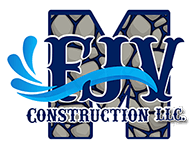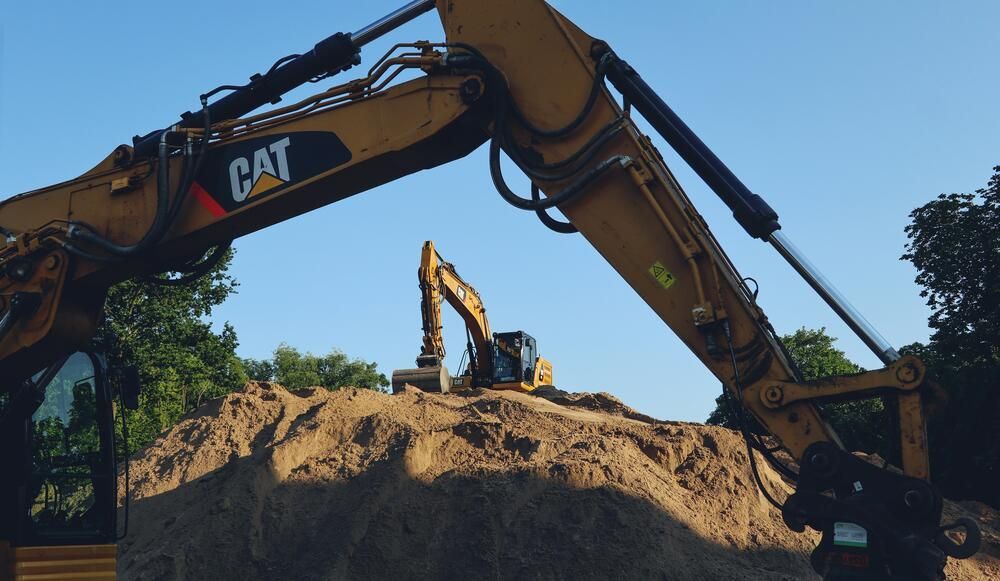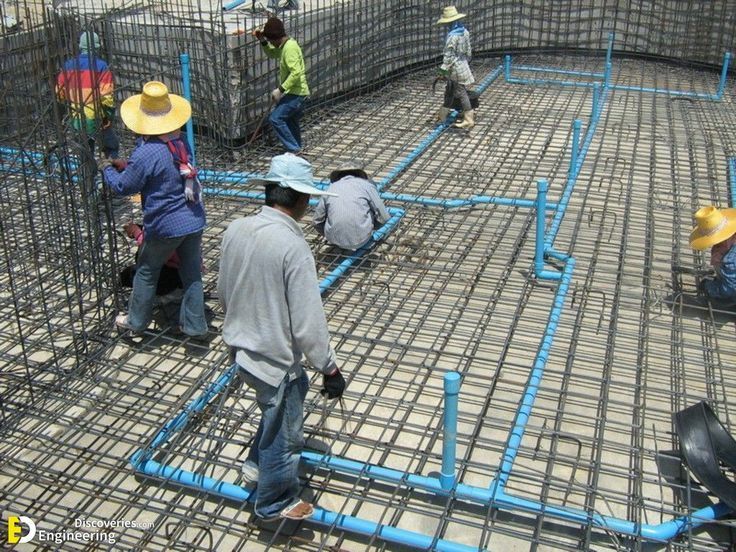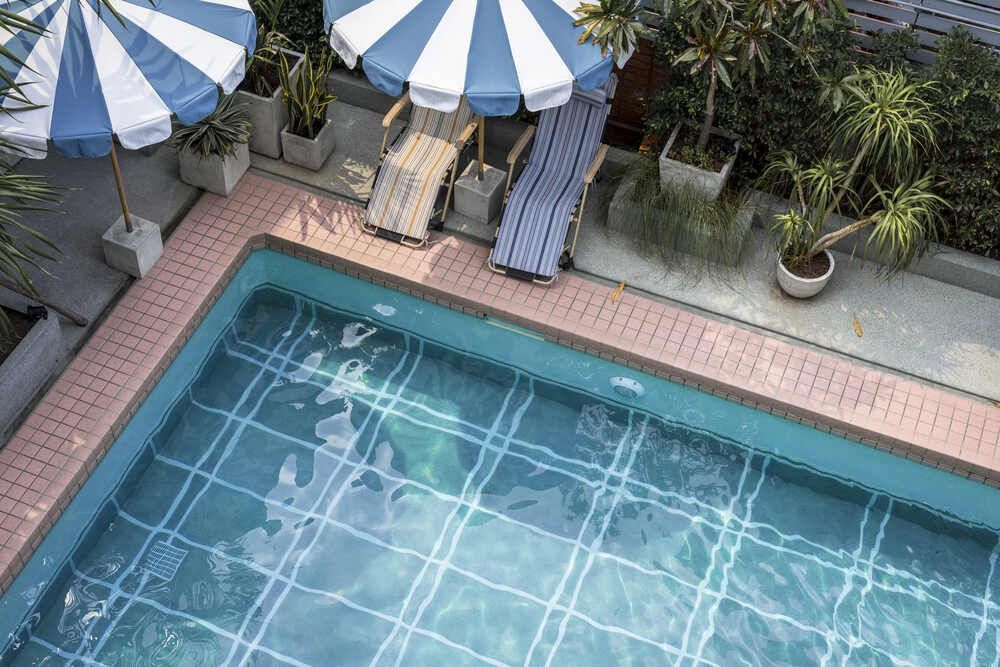6 Pool Installation Considerations for Homes in High-Wind Zones

A residential pool offers space for relaxation, exercise, and entertainment, and the United States leads the way withan estimated 10.6 million residential swimming pools. However, in high-wind zones, these benefits come with unique challenges that require careful planning in pool installation. Strong winds can lead to debris buildup, structural damage, and water quality issues, making it essential to consider wind-resistant designs, materials, and features.
Here are six critical factors to consider for a successful pool installation in high-wind areas.
Table of Contentstes
Key Takeaways
1. Select Wind-Resistant Pool Designs
2. Prioritize High-Quality Construction Materials
3. Install Secure Pool Covers and Enclosures
4. Ensure Proper Drainage Systems
5. Reinforce Pool Fencing and Barriers
6. Choosing Wind-Resistant Pool Features
How to Select a Reliable Pool Installer for High-Wind Zones
Frequently Asked Questions (FAQs)
Trust FJV Construction in Danbury, CT, for Reliable Pool Installation!
Key Takeaways
✔ Selecting wind-resistant pool designs reduces structural damage and minimizes debris accumulation in high-wind zones.
✔ High-quality materials like reinforced concrete and weather-resistant finishes ensure durability and reduce maintenance needs.
✔ Secure covers and enclosures protect pools from debris, maintain water quality, and enhance safety during strong winds.
✔ Proper drainage systems prevent pool overflow, protect landscaping, and reduce water damage to surrounding features.
✔ Reinforced fencing and barriers safeguard the pool area from debris and comply with safety regulations in high-wind zones.
✔ Wind-resistant pool features like anchored furniture and in-ground lighting minimize hazards.
✔ Choosing a professional installer with expertise in high-wind zones ensures a durable, compliant, and tailored pool installation.
1. Select Wind-Resistant Pool Designs
High-wind zones require strategic pool designs that reduce wind impact and enhance durability. Certain pool shapes and layouts withstand turbulent conditions better, which minimizes damage risks. Choosing a wind-resistant pool design ensures longevity and maximizes the value of the pool installation.
Why Wind-Resistant Designs Matter
Reduces Wind Damage to Pool Structures
Pools with simpler shapes experience less pressure from strong winds, which helps prevent cracks or stress fractures. In contrast, complex designs with sharp angles or intricate edges can trap wind, which increases the likelihood of structural issues over time.
Minimizes Surface Water Disruption
High winds can create strong ripples or waves that damage pool edges and displace water. Wind-resistant designs with lower surface exposure maintain water stability and reduce splash-out.
Supports Longevity of Surrounding Features
Poolside structures like decks and coping last longer with layouts that deflect wind forces. Properly designed pools channel wind away and protect nearby materials from unnecessary wear and tear.
How to Choose Wind-Resistant Designs
Opt for Low-Profile Shapes
Rectangular or oval pools with low walls experience less wind resistance compared to elevated or freeform designs. This reduces pressure on the pool structure and minimizes wind-related strain.
Incorporate Wind-Blocking Landscaping
Strategically placed windbreaks, such as dense shrubs or walls, protect the pool area from gusts. These elements prevent debris from reaching the pool, which can cause significant damage.
Consult Professionals for Zone-Specific Layouts
Pool installation experts can assess the property’s wind patterns and recommend layouts tailored to the location. This ensures the design integrates durability, safety, and visual appeal.
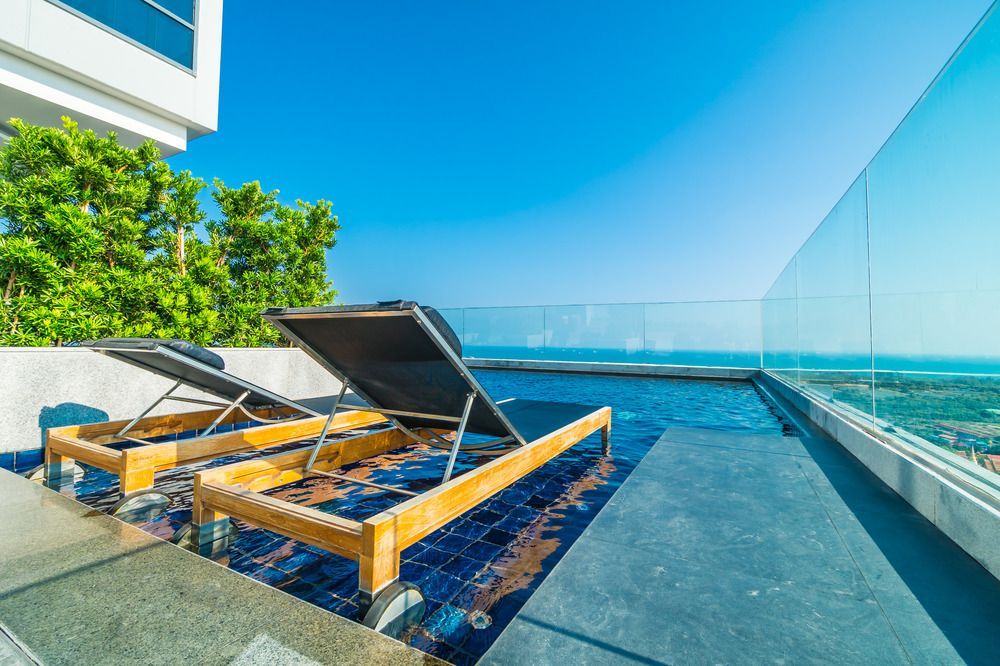
2. Prioritize High-Quality Construction Materials
High-wind zones demand materials that can endure the harsh conditions without compromising functionality or appearance. From the pool shell to the decking, selecting durable, wind-resistant materials ensures the pool remains intact through extreme weather. Investing in high-quality materials helps maximize the lifespan and performance of the pool installation.
Why Material Quality Matters
Prevents Cracking and Structural Failure
Materials like reinforced concrete and fiberglass provide strength to resist pressure from wind-related vibrations. Cheaper materials may crack or deteriorate over time, leading to costly repairs.
Protects Against Wind-Carried Debris
High-quality finishes are less prone to scratches and dents caused by debris carried by strong winds. Materials with scratch-resistant coatings maintain their appearance even after storms.
Minimizes Long-Term Maintenance Costs
Durable materials reduce the need for frequent repairs or replacements, making the pool installation more cost-effective. High-quality options are also better equipped to handle high-wind wear and tear.
How to Choose High-Quality Materials
Use Reinforced Concrete or Fiberglass for the Pool Shell
These materials offer high structural integrity, making them ideal for pools in windy regions. Reinforced concrete provides exceptional durability and can be customized to withstand extreme weather conditions. Fiberglass, in particular, can flex slightly without cracking under pressure.
Invest in Weather-Resistant Decking
Materials like stamped concrete or natural stone resist wind damage better than wood or softer options. Choose slip-resistant finishes to improve safety during wet and windy conditions.
Select Corrosion-Resistant Fixtures
Opt for stainless steel or powder-coated aluminum for pool ladders, rails, and other accessories. These materials withstand exposure to moisture and airborne salts common in high-wind zones.
3. Install Secure Pool Covers and Enclosures
High winds can carry debris and pollutants into pools, making covers and enclosures essential for protection. These features safeguard the pool installation by ensuring safety within the site, especially for installers and other professionals working on the project. Choosing the right covers and enclosures can also enhance the pool's resilience to windy conditions.
Why Covers and Enclosures Are Critical
Prevents Debris from Damaging Equipment
A properly secured cover keeps leaves, branches, and other wind-blown debris out of the pool. This protects the filtration system from clogs and mechanical issues.
Maintains Water Quality
Enclosures create a barrier against dirt and pollutants that high winds often carry. This reduces the need for frequent chemical treatments and ensures cleaner water during the pool installation.
Improves Safety During Storms
Covers and enclosures prevent accidents caused by strong gusts pushing unsecured objects into the pool area. This adds an extra layer of protection for both the pool and surrounding space.
How to Install Secure Options
Choose Wind-Rated Covers
Look for retractable or heavy-duty covers specifically designed to handle high winds. These models usually come with secure anchor systems to keep them in place.
Install Reinforced Enclosures
Use materials like polycarbonate or tempered glass for pool enclosures. These options offer durability through their resistance to cracking, warping, and impact from wind-carried debris. Their transparency and sleek finishes also maintain visibility and blend seamlessly with modern pool designs, which enhances the pool’s aesthetic appeal.
Ensure Proper Anchoring
Secure covers and enclosures with heavy-duty fasteners or integrated anchor points. It’s best to regularly inspect and tighten anchors to maintain their strength during the installation process.
4. Ensure Proper Drainage Systems
High winds often accompany heavy rainfall, making efficient drainage systems crucial for preventing pool damage. Proper drainage reduces the risk of flooding and helps protect the surrounding landscape. A well-designed system ensures the pool installation remains functional even during extreme weather.
Why Drainage Systems Are Necessary
Prevents Pool Overflow
Excess rainwater combined with strong winds can cause the pool to overflow and damage nearby structures. Drainage systems redirect water away, keeping the area safe.
Protects Landscaping
Without proper drainage, pooling water can erode soil and harm plants around the pool. A well-planned system during the pool installation ensures safety within the surrounding environment.
Reduces Water Damage to Decking
Standing water on the pool deck can weaken materials and create safety hazards. Effective drainage prevents prolonged water exposure, which can lead to warping, cracking, or the growth of mold and mildew that further compromises the pool’s safety.
How to Implement Effective Drainage
Install Deck Perimeter Drains
These drains channel water away from the pool and deck, preventing puddles and overflow issues. It’s important for property owners to ensure the drains are designed to handle high volumes of water. Hiring a professional helps ensure this process.
Use Surge Tanks for High Capacity
Surge tanks temporarily store excess water during heavy rainfall. Having a high-capacity unit prevents strain on the primary drainage system and avoids flooding.
Incorporate Permeable Decking
Decking materials with permeable surfaces allow water to flow through instead of pooling. This minimizes slipping hazards for people working in the site and enhances overall drainage.
5. Reinforce Pool Fencing and Barriers
Wind-resistant fencing and barriers protect the pool area from debris and ensure safety in high-wind zones. These features are especially important to comply with local safety regulations. Properly installed barriers also make the pool installation more secure and durable.
Why Reinforced Fencing Matters
Deflects Wind-Carried Debris
Strong fences reduce the impact of debris blown into the pool area, protecting the pool and surrounding features. Weak barriers may collapse under high winds.
Enhances Safety During High Winds
Fencing prevents children, pets, or objects from being blown into the pool during storms. Proper fencing and barriers are essential to prevent unauthorized access especially for children aged 1 to 4 years, who have the highest drowning rates worldwide.
Complies with Building Codes
Many high-wind zones have strict regulations, such as requiring fences to withstand wind speeds of up to 120 mph. Reinforced fencing ensures the pool meets local standards.
How to Install Reinforced Fencing
Use Sturdy Materials
Choose fences made of powder-coated metal or composite materials that resist wind pressure. These options are durable and low-maintenance, making them a cost-effective choice for protecting the installation site.
Incorporate Wind-Permeable Designs
Slatted or lattice-style fencing allows air to pass through, which reduces wind resistance. This minimizes the risk of the barrier being knocked over, which can damage the pool structure and surrounding areas.
Anchor Fencing Securely
Opt for heavy-duty posts and secure them deeply into the ground. Additionally, regularly inspect the fence to ensure all components remain stable after storms.
6. Choosing Wind-Resistant Pool Features
Poolside features should be carefully selected to withstand high winds without becoming hazards. From furniture to lighting, durable and secure options are essential in windy environments. Thoughtfully chosen features enhance the safety and longevity of the pool installation.
Why Feature Selection Is Important
Reduces Damage to Pool Equipment
Lightweight features like pool covers or umbrellas can be blown into the pool, which can damage the structure or installation equipment. Having wind-resistant options can prevent such risks.
Minimizes Hazards During High Winds
Unsecured furniture or accessories can become projectiles and pose safety hazards. Choosing heavy, anchored features for the pool installation reduces the likelihood of accidents.
Ensures Long-Term Functionality
Wind-resistant features last longer, which translates to fewer repairs and reduced replacement costs. Durable designs also maintain their appearance even after severe weather.
How to Select Suitable Features
Choose Heavy Pool Furniture
Select chairs, loungers, and tables made from metal or weighted materials. Secure them to the ground with anchors for added stability.
Opt for Fixed Poolside Accessories
Features like diving boards and handrails should be securely bolted to withstand wind pressure. Avoid portable options that may shift during storms.
Invest in Windproof Lighting Systems
Use fixtures designed to remain stable in high winds. Integrated, in-ground lighting is an ideal choice as it can withstand the impact of high winds.
How to Select a Reliable Pool Installer for High-Wind Zones
Choosing the right pool installer in Danbury, CT, is crucial for a pool installation that can withstand high-wind conditions. An experienced installer will not only create a safe and durable pool but also help navigate local regulations and tailor the design to the property’s unique needs. Here are key factors to consider when selecting a pool installer for high-wind zones:
1. Experience in High-Wind Zone Installations
Installers with a proven track record in high-wind zones understand the unique challenges of these environments. They are familiar with wind-resistant designs, materials, and construction techniques that improve a pool’s durability. Checking for references or past projects in similar locations can provide confidence in their expertise and ability to deliver a reliable pool installation.
2. Knowledge of Local Building Codes and Regulations
High-wind zones often have specific building codes governing pool installations, such as requirements for fencing, enclosures, or materials. A qualified installer will be well-versed in these regulations and ensure compliance to avoid costly fines or safety issues. Confirming their understanding of local rules also ensures the project proceeds smoothly and adheres to all safety standards.
3. Assess Customization Capabilities
Every property in a high-wind zone has unique characteristics, such as terrain, wind patterns, and landscaping. A skilled installer will offer tailored solutions, including custom pool designs and layouts that minimize wind impact. This approach ensures the pool installation fits the property while maintaining both functionality and aesthetic appeal.
4. Warranty and Maintenance Services
A reliable installer will provide warranties on both materials and workmanship during the pool installation. This will offer peace of mind for the long-term performance of the pool installation. They may also offer maintenance packages specifically for high-wind zones, to address issues like debris accumulation, drainage efficiency, or damage from storms.
5. Communication and Project Management Skills
Effective communication and project management are essential for a successful pool installation. An installer who listens, provides clear timelines, and keeps clients informed ensures the project stays on track. In high-wind zones, this level of organization is especially important to address weather-related delays or adjustments promptly.
6. Quality Certifications and Industry Affiliations
Reputable pool installers often hold certifications or belong to industry associations that indicate their commitment to quality and best practices for pool installation. Certifications from organizations like the Pool & Hot Tub Alliance (PHTA) or local contractor boards demonstrate expertise and adherence to high standards. Installers with these credentials are more likely to use premium materials and proven techniques. Additionally, industry affiliations may connect installers with specialized resources for challenging environments.
Frequently Asked Questions (FAQs)
Can a pool be installed on a property with uneven terrain in a high-wind zone?
Yes, pools can be installed on uneven terrain in high-wind zones, but it requires careful planning and expertise. Installers often use retaining walls, terracing, or reinforced foundations to stabilize the pool and surrounding area. These methods not only level the ground but also help manage wind flow and minimize erosion. Working with an experienced installer ensures the design is both structurally sound and visually appealing.
Are infinity pools suitable for high-wind zones?
Infinity pools can be installed in high-wind zones, but they require specialized design adjustments. Strong winds may impact the vanishing edge and water flow, so reinforced construction and wind deflectors are often recommended. Additionally, protective landscaping or enclosures can reduce wind exposure while maintaining the pool's aesthetic appeal.
Do solar pool heaters work efficiently in high-wind areas?
Solar pool heaters can work in high-wind areas, but their efficiency may decrease if the panels are improperly installed. Wind can cool the panels, reducing their ability to absorb and transfer heat. To combat this, installers can use wind shields or position panels in less exposed areas. Proper anchoring and regular maintenance also ensure solar heaters perform optimally despite high winds.
What type of pool lighting is best for high-wind zones?
In-ground or flush-mounted LED lighting is ideal for high-wind zones because it is protected from wind damage and debris impact. Floating or above-ground lights are more likely to be displaced or broken during storms. LED lights are durable, energy-efficient, and can be securely integrated into the pool's structure.
How does wind affect pool water evaporation rates?
High winds significantly increase evaporation rates by moving the water surface and carrying away moisture. This can lead to higher water loss, increased chemical usage, and more frequent refills. Installing windbreaks, such as fences or shrubs, and using a pool cover when the pool is not in use can minimize evaporation.
Trust FJV Construction in Danbury, CT, for Reliable Pool Installation!
FJV Construction specializes in expert pool installation services in Danbury, CT, providing homeowners with durable and stylish pools tailored to their needs. With extensive experience in designing and building pools for high-wind zones, FJV Construction ensures every project meets the highest standards of safety, functionality, and visual appeal. When creating wind-resistant designs, our team delivers results that enhance outdoor spaces while withstanding the elements.
Contact us today to bring a long-lasting, expertly crafted pool to life for your home!
Our Info
Monday to Friday from 7 am to 6 pm
Saturdays from 8 am to 5 pm
We Accept Cash and Checks
LOCATION
We Cover 80 Miles around Bethel,
Danbury, and Brookfield
Bethel, Connecticut 06801
Danbury, Connecticut 06810
Brookfield, Connecticut 06804
Navigation
Copyright FJV Construction, All Rights Reserved
